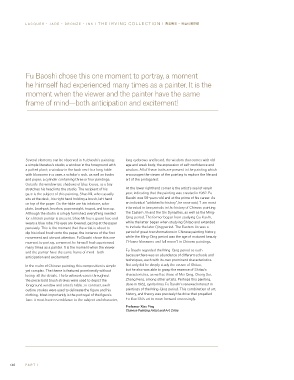Page 148 - Christie's Irving Collection Lacquer Bronse jade and Ink March 2019
P. 148
I
L A C Q U E R • J A D E • B R O N Z E • I N K T H E R V I N G C O L L E C T I O N 髹金飾玉 - 歐雲伉儷珍藏
Fu Baoshi chose this one moment to portray, a moment
he himself had experienced many times as a painter. It is the
moment when the viewer and the painter have the same
frame of mind—both anticipation and excitement!
Several elements can be observed in Fu Baoshi’s painting: long eyebrows and beard, the wisdom that comes with old
a simple literatus’s studio, a window in the foreground with age and weak body, the expression of self-confdence and
a potted plant; a window in the back next to a long table wisdom. All of these traits are present in the painting which
with blossoms in a vase, a scholar’s rock, as well as books encourages the viewer of the painting to explore the life and
and paper; a cylinder containing three or four paintings. art of the protagonist.
Outside the window are shadows of blue leaves, as a boy
stretches his head into the studio. The recipient of his At the lower righthand corner is the artist’s seal of renyin
gaze is the subject of this painting, Shao Mi, who casually year, indicating that the painting was created in 1962. Fu
sits at the desk , his right hand holding a brush, left hand Baoshi was 58-years-old and at the prime of his career. As
on top of the paper. On the table are his inkstone, color an individual “addicted to history”, he once said, “I am most
plate, brushpot, brushes, paperweight, teapot, and teacup. interested in two periods in the history of Chinese painting:
Although the studio is simply furnished, everything needed the Eastern Jin and the Six Dynasties, as well as the Ming-
for a literati painter is present. Shao Mi has a gaunt face and Qing period. The former began from studying Gu Kaizhi,
wears a blue robe. His eyes are lowered, gazing at the paper while the latter began when studying Shitao and extended
pensively. This is the moment that the artist is about to to include the later Qing period. The Eastern Jin was a
dip his inked brush onto the paper, the instance of the frst period of great transformations in Chinese painting history,
movement and utmost attention. Fu Baoshi chose this one while the Ming-Qing period was the age of matured beauty
moment to portray, a moment he himself had experienced (“Flower blossoms and full moon”) in Chinese paintings.
many times as a painter. It is the moment when the viewer
Fu Baoshi regarded the Ming-Qing period as such
and the painter have the same frame of mind—both
because there was an abundance of diferent schools and
anticipation and excitement!
techniques, each with its own prominent characteristics.
In the realm of Chinese painting, this composition is simple Not only did he deeply study the oeuvre of Shitao,
yet complex. The theme is featured prominently without but he also was able to grasp the essence of Shitao’s
losing all the details. The brushwork varies throughout characteristics, as well as those of Mei Qing, Cheng Sui,
the piece: bold brush strokes were used to depict the Zhang Feng, among other artists. Perhaps this painting,
foreground window and artist’s table ; in contrast, swift done in 1962, symbolizes Fu Baoshi’s renewed interest in
outline strokes were used to delineate the fgure and his paintings of the Ming-Qing period. This combination of art,
clothing. Most importantly is the portrayal of the fgure’s history, and theory was precisely the drive that propelled
face: it must have resemblance to the subject and character, Fu Bao Shi’s art to move forward unceasingly.
Professor Xiao Ping
Chinese Painting Artist and Art Critic
146 P A R T I

